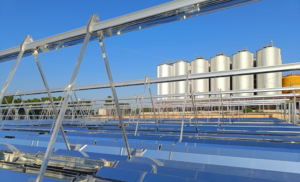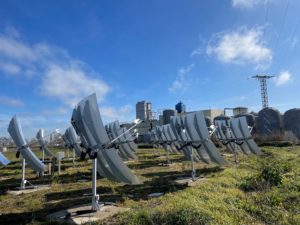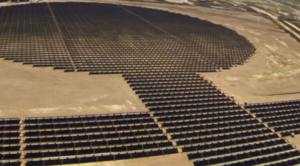

Solar Process Heat: European Commission Advocates More Research
In March, almost 40 scientists, engineers and solar process heat specialists met for the 1st workshop of the European InSun project, called “Exchange of experience made with the design and installation of solar process heat systems”, which was hosted at the Institute for Solar Technology SPF in Rapperswil, Switzerland. The workshop focused on the experiences with the planning and installation of roof- or ground-mounted solar process heat systems – lead times, project schedule, as well as standards, guidelines and regulations in the different European countries. The photo shows a process heat project in Italy with 1.3 MW Fresnel collectors for the brick industry.
The pros and cons of different heat transfer fluids, such as thermal oil or direct steam generation, were also discussed at the InSun workshop. In addition, the workshop included an evaluation of the technological storage options and the potential of cost reductions for systems available on the market. In fact, although InSun initiated the workshop, there were participants from Japan and Tunisia as well. “At this stage of development, it is very important to meet frequently and share information in a very open way, especially as several EU projects run simultaneously,” says Uli Jakob, Director of dr. jakob energy research, which has organised the workshop for German InSun coordinator zafh.net.
Some of the key issues of the InSun workshop:
- The legal effort should not be underestimated, particularly in terms of construction permits and restrictions. Especially regional and local law can be tricky at some installation sites, as it is different at every place. For example, at a solar process heat plant in Spain, it turned out that regional law demands that all kind of construction projects keep a certain distance from national roads, so the original plans for the plant had to be changed (see the attached presentation by Solera).
- Statics should be taken into account from the very beginning. Roofs of industrial buildings are often not designed to carry additional weight (see the attached presentation by S.O.L.I.D).
- There was an information exchange on the choice of heat transfer fluids which are also suitable for higher temperatures. Klaus Hennecke from the German Aerospace Center, DLR, compared the pros and cons of the different solutions (see attached presentation by DLR):
- water (0°C to 230 °C at a pressure of 30 bar)
- water/steam (0°C to 250 °C, with phase change)
- water-glycol (-30 °C to 170 °C)
- thermal oils
- VP1, which is the most common fluid used in parabolic trough electricity plants (15 °C to 400 °C, but toxic)
- Syltherm 800, which has a higher price but can be an interesting alternative, especially for process heat due to easier handling (-40 °C to 400 °C, non-toxic).
In addition, Elimar Frank, Research Director at SPF, has outlined some of the key findings of the technology workshop on solar process heat for industry, which took place in Brussels in March. About 50 participants followed the invitation of the Solar Thermal Technology Panel of the European Technology Platform on Renewable Heating and Cooling. The Research Director of SPF confirms that the representatives of the European Commission have made it very clear that they had a great interest in further research in the field of solar process heat.
- The industry is interested, but hesitating due to little well-documented experience in the field. Therefore, funded reference projects which include the description of results and best practise are crucial. “As several large projects are now up and running, we are optimistic that this will encourage others to follow,” says Frank. At the Göss brewery in Austria, the first solar brewing process with the heat of the 1,400 m2 collector area started in May. Best practise data is also being gathered and discussed within IEA SHC Task 49.
- Energy Service Company (ESCO) models are very interesting, but also difficult to calculate. To be profitable for the contractors, the model often requires long contract times of 15 to 20 years, because solar process heat plants cannot be easily disassembled and moved to another place and the specific integration concept and planning accounts for more than half of the investment costs. Usually, the industry does not want to make such a long-term commitment.
- The planning needed to integrate a solar thermal system into a plant is still complicated and expensive. However, an elaborated and suitable integration concept is very important to achieve low heat prices and high energy savings, as the initial investment costs for the solar plant are high. The fact that the detailed system design may change the estimated heat price significantly is an additional barrier for many companies.
- Also, solar companies have different roles in planning and integration. In general, supporting the customer with planning, integration and installation is advantageous. But turn-key is usually not the solution, as the energy technology in the industry is complex and there are often in-house engineers to take care of this issue. A close corporation will be needed and the responsibilities of the engineers and the solar companies need to be defined.
More information:
http://www.fp7-insun.eu/
http://www.hft-stuttgart.de/Forschung/Projekte/Projekt85.html/en
http://www.eurac.edu
http://www.soltigua.com
http://www.solera.de
http://www.solid.at
http://www.solarenergy.ch
http://www.rhc-platform.org


